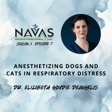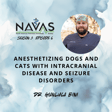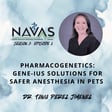
Dr. Daniel Sakai on Effective Clinical Use of Neuromuscular Blocking Agents
Happy Halloween, and welcome to another chilling episode of the NAVAS podcast, where we venture into the eerie depths of veterinary anesthesia! Join us as we lift the curtain on a topic that, while vital to advanced anesthesia practice, often sends shivers down the spine of even the bravest veterinary professionals—neuromuscular blocking agents (NMBAs) in veterinary patients.
While paralytic agents play an important role in providing excellent quality muscle relaxation that can help facilitate a variety of procedures, their use often spooks even the seasoned anesthetist, as they can cause frightening problems if not used with great care. After listening to this episode, we hope you can avoid a jump scare anytime you need to use NMBA.
Our guest for this spine-tingling episode is the highly esteemed Dr. Daniel Sakai from the University of Georgia College of Veterinary Medicine. Dr. Sakai, boarded veterinary anesthesiologist, has conducted extensive research on NMBAs, exploring their invaluable role in patient immobilization as well as how to optimize recovery from neuromuscular blockade. He’s here to help us demystify these powerful agents, dissect their practical applications, and reveal how to use them safely and effectively to prevent any nightmarish outcomes for your patients.
So, as the leaves fall and the shadows lengthen, grab a cozy blanket, tune in, and get ready to learn from one of the top minds in veterinary anesthesia. Just be warned—this episode might leave you spellbound!
If you like what you hear, we have a couple of favors to ask of you:
Become a member of NAVAS for access to more anesthesia and analgesia educational and RACE-approved CE content.
Spread the word. Share our podcast on your socials or a discussion forum. That would really help us achieve our mission: Reduce mortality and morbidity in veterinary patients undergoing sedation, anesthesia, and analgesia through high-quality, peer-reviewed education.
Thank you to our sponsor, Dechra - learn more about the pharmaceutical products Dechra has to offer veterinary professionals, such as Zenalpha.
If you have questions about this episode or want to suggest topics for future episodes, reach out to the producers at education@mynavas.org.
All opinions stated by the host and their guests are theirs alone and do not represent the thoughts or opinions of any corporation, university, or other business or governmental entity.











